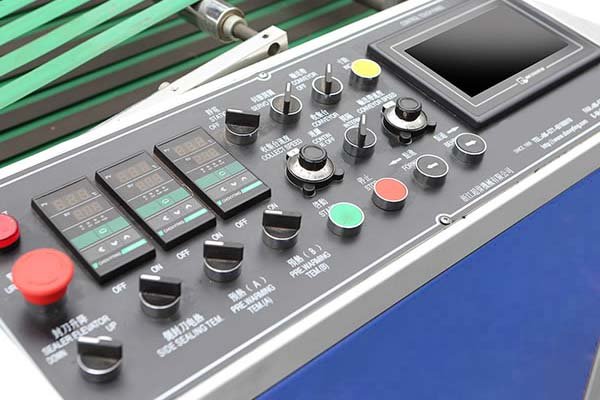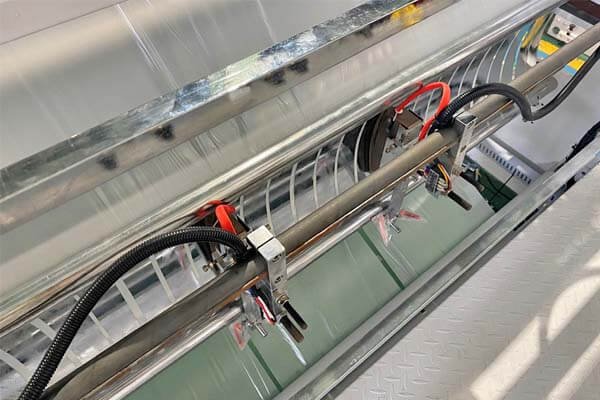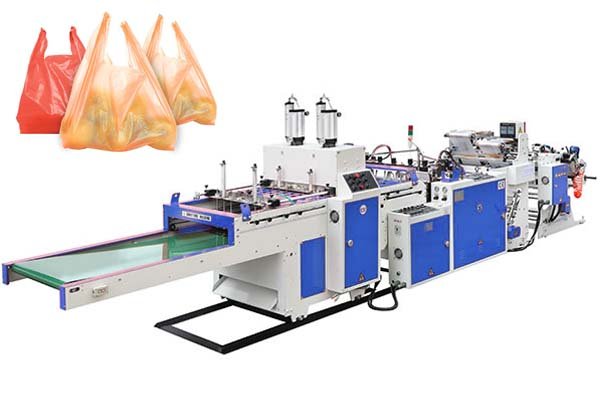
Choosing a T-shirt bag machine can be confusing. You worry that the wrong choice will limit your growth or waste your investment. We make it simple by explaining the key differences.
The main difference is production output. A 2-line machine is for entry-level needs. A 3-line machine offers a balance of speed and cost. A 4-line machine is built for high-volume, industrial-scale production.
This choice directly impacts your factory's efficiency and profitability. A 2-line model is a great starting point for new businesses or smaller markets. It requires a lower initial investment and is easier to operate. A 3-line machine is a step up. It suits growing businesses that need more output without the full cost of a 4-line system. The 4-line machine is our powerhouse. It delivers the highest output and the lowest cost per bag, making it ideal for large-scale operations supplying major retailers.
Understanding these tiers is the first step. Your decision should align with your current production demands, your budget, and your plans for future growth. We design our machines to fit these different needs. For example, our T-Shirt Bag Making Machines range from $17,000 to $32,000. This price variation reflects the complexity and output capacity of each model. Our goal is to provide a solution that works for you, whether you are just starting or expanding your production capacity significantly.
What’s the Difference Between 2-Line, 3-Line, and 4-Line Machines?
It's easy to get lost in technical terms. We want to make this clear so you can see exactly what you are investing in. Let's break down the core mechanical differences.
The key difference is the number of parallel production lanes on the machine. A 2-line machine processes two lines of bags at once from a film roll. A 4-line machine processes four lines simultaneously, doubling the output from a similar footprint.

The Mechanics Behind the Lines
The concept of "lines" is central to how these machines work. It's not just about speed; it's about the entire mechanical and electronic configuration.
The Core Concept: Production Lanes
Imagine a single, wide roll of plastic film feeding into the machine.
- A 2-Line Machine splits this film's path into two separate, parallel lanes. Each lane has its own sealing bar and cutting knife. It produces two bags for every cycle of the machine.
- A 3-Line Machine splits the path into three lanes. This setup is a bit more complex. It often uses a wider film roll or a more intricate feeding system to manage the three streams. It produces three bags per cycle.
- A 4-Line Machine is typically designed in a double-decker or stacked configuration. It uses two layers of film, each split into two lanes. This clever design allows it to produce four bags per cycle without doubling the machine's floor space.
Material Flow and Stability
More lines mean more complexity in managing the plastic film.
- Film Tension: Our 4-line machines feature our patented "Smart Tension Control." This system is critical because it ensures all four film lanes feed at the same consistent speed. Poor tension control on a multi-line machine leads to bag defects and material waste.
- Sealing and Cutting: With four lines running, the sealing and cutting mechanisms must be perfectly synchronized. Our high-carbon steel components and precise laser calibration during assembly ensure every bag is sealed and cut to the exact same specifications, even at top speeds.
Machine Footprint and Operator Requirements
The physical size and the skill needed to run the machine also change. Here is a simple breakdown:
| Feature | 2-Line Machine | 3-Line Machine | 4-Line Machine |
|---|---|---|---|
| Typical User | Startups, Small Shops | Growing Businesses | Large Factories, Mass Producers |
| Footprint | Smallest | Medium | Large (Often taller) |
| Film Width | Standard | Wider | Standard (Uses two rolls) |
| Complexity | Low | Medium | High |
| Operator Skill | Basic | Intermediate | Advanced |
| Our Price Range | $17,000 - $21,000 | $22,000 - $26,000 | $27,000 - $32,000+ |
This shows that moving from a 2-line to a 4-line is not just about getting more bags. It is about investing in a more complex, robust, and powerful production system.
Production Output Comparison: How Many Bags Per Hour Can Each Type Make?
Your main goal is production. You need to know exactly how many bags you can make in a day. Let's look at the real-world numbers you can expect from our machines.
A standard 2-line machine produces about 200-400 bags per minute. A 3-line machine increases this to 300-600 bags per minute. Our high-speed 4-line machines can produce 400-800 bags per minute, delivering maximum throughput for large orders.
Calculating Your Production Capacity
These numbers are a great starting point, but let's put them into a practical context. Your hourly and daily output determines your ability to meet customer demand and generate revenue.
Output at a Glance
This table shows the potential production capacity. We calculate this based on an average operating speed. Our machines are tested for 72 hours continuously to ensure they can sustain these speeds.
| Machine Type | Lines | Speed (Bags/Min per Line) | Total Bags/Minute | Total Bags/Hour | Total Bags/8-Hour Shift |
|---|---|---|---|---|---|
| BagMec® 2-Line | 2 | 100 - 200 | 200 - 400 | 12,000 - 24,000 | 96,000 - 192,000 |
| BagMec® 3-Line | 3 | 100 - 200 | 300 - 600 | 18,000 - 36,000 | 144,000 - 288,000 |
| BagMec® 4-Line | 4 | 100 - 200 | 400 - 800 | 24,000 - 48,000 | 192,000 - 384,000 |
Note: Actual output can vary based on bag size, film thickness, and material type (LDPE, HDPE, biodegradable).
Factors That Affect Real-World Speed
The numbers in the chart are achievable under ideal conditions. In your factory, a few things will influence the actual speed:
- Material Quality: Using high-quality, consistent film rolls is very important. Poor quality film can tear at high speeds, causing downtime. Our machines work with LDPE, HDPE, PP, and even biodegradable PLA films.
- Operator Skill: A well-trained operator can set up the machine faster, troubleshoot minor issues, and keep it running at optimal speed. We offer on-site installation and training services to help your team.
- Maintenance: Regular maintenance is key. Our machines are designed for durability, but following our recommended maintenance schedule will prevent unexpected stops and ensure a long lifespan. We even offer IoT-enabled machines for remote diagnostics.
Function and Configuration Differences: Speed, Stability, and Automation Level
Higher speed requires better technology. A machine running four lines at once needs more advanced components than a simpler 2-line model. Let's explore the key engineering differences.
4-line machines use multiple high-performance servo motors for precise control and stability at high speeds. 2-line machines can use simpler motor systems. All our models, from 2-line to 4-line, come with fully automated PLC touchscreen controls.

A Look Inside the Technology
The difference in performance comes from the quality and sophistication of the components inside. At BagMec®, we build our machines for reliability and efficiency. This is part of our ISO 9001 quality management system.
Servo Motors: The Engine of Production
The motor is the heart of the machine.
- 2-Line and 3-Line Machines: These often use a main AC motor with inverters or standard servo motors. This provides enough power and control for their production speeds. The system is reliable and cost-effective.
- 4-Line Machines: Our 4-line models use a full servo motor system. This means there are multiple, independent servo motors controlling different parts of the machine, like the film feeding, sealing, and cutting. This provides the extremely high precision needed to keep four lines synchronized perfectly. It also allows for faster acceleration and deceleration, increasing overall output. A bonus is that our energy-saving servo motors can reduce power consumption by up to 30%.
Control Systems and Automation
How the operator interacts with the machine is also important.
- PLC Control: All our T-shirt bag machines, regardless of the number of lines, are equipped with a Programmable Logic Controller (PLC). This is the machine's "brain." It ensures all actions happen in the correct sequence.
- Touchscreen Interface: We use user-friendly color touchscreens. Our interfaces are available in multiple languages, including English, Spanish, and Chinese. This makes it easy for operators to set bag length, speed, and temperature. It also displays error messages for quick troubleshooting.
- Automation Level: All models are fully automatic. Once the film roll is loaded and the parameters are set, the machine runs by itself. It will automatically stop if it runs out of film or if a fault is detected, meeting all CE safety standards.
Feature Comparison Table
| Feature | BagMec® 2-Line | BagMec® 3-Line | BagMec® 4-Line |
|---|---|---|---|
| Motor System | Standard Servo / AC Motor | High-Performance Servo | Full Multi-Servo System |
| Control System | PLC with Touchscreen | PLC with Touchscreen | Advanced PLC with Touchscreen |
| Tension Control | Standard Mechanical/Auto | Automatic | Patented "Smart Tension Control" |
| Stability | Excellent | Excellent | Superior (for high speeds) |
| Energy Use | Standard | Efficient | 30% Reduced Consumption |
Use Case Suggestions: Which Machine Type Fits Your Factory Size and Needs?
Now that you know the differences, let's match the machine to your business. The right choice depends on your specific situation. We have helped over 500 customers in 50+ countries find the perfect fit.
Small businesses or startups should start with a 2-line machine. Growing, medium-sized factories looking to increase capacity should choose a 3-line. Large, established producers supplying major chains need the efficiency of a 4-line machine.
Finding Your Profile
We work with a wide range of customers. Here are some typical profiles that might look familiar to you.
The Startup or Small Business Profile (2-Line Machine)
- Who you are: You are a new business, a small workshop, or serving a local market. Your order volumes are small to medium.
- Your Needs: You need a reliable, affordable machine that is easy to operate. Your budget is a key consideration, perhaps like Priya Kapoor in India, who needed a compact courier bag machine under $50,000. A 2-line T-shirt bag machine fits this perfectly.
- Why it works: The lower initial investment (around $17,000-$21,000) makes it accessible. Its smaller footprint fits in limited factory space. The simple operation means you can train staff quickly. It provides enough output to build your business and establish a customer base.
The Growing Medium-Sized Factory (3-Line Machine)
- Who you are: You have been in business for a few years. Your customer base is expanding, and you are getting larger, more frequent orders. Your 2-line machine is now running at full capacity.
- Your Needs: You need to increase production significantly but may not be ready for the top-tier investment of a 4-line. You need a balance between output, cost, and space.
- Why it works: A 3-line machine provides a 50% output increase over a 2-line machine for a moderate increase in cost. It is the logical next step for expansion. It allows you to take on bigger clients and improve your delivery times without a major operational overhaul.
The Mass Production Leader (4-Line Machine)
- Who you are: You are a large, established packaging manufacturer. You supply supermarkets, large retail chains, or export markets. Efficiency and low cost-per-bag are your top priorities.
- Your Needs: You need maximum output, speed, and reliability. You run multiple shifts and need a machine that can handle continuous, high-volume production. You might be like our German packaging client who needed 99% uptime and reduced material waste.
- Why it works: The 4-line machine is an industrial workhorse. Its high output (up to 48,000 bags/hour) drastically lowers the cost of producing each bag. Features like our energy-saving motors and "Smart Tension Control" save you money on power and materials over the long term. This machine is an investment in market leadership.
Buying Advice: Budget vs. Efficiency — How to Make the Right Trade-Off
The final decision often comes down to money. You need to balance the upfront cost of the machine with the long-term efficiency and profitability it brings. Let's discuss how to make a smart financial decision.
A 2-line machine has the lowest initial cost, making it great for tight budgets. A 4-line machine costs more upfront but offers a lower cost-per-bag, providing a better return on investment (ROI) over time for high-volume producers.
Making a Smart Investment
We believe in being transparent about costs. This helps you plan your investment and understand the long-term value. Our T-Shirt Bag Making Machines range from $17,000 to $32,000, and this price reflects the machine's capability.
Analyzing the Initial Investment (CapEx)
Your capital expenditure (CapEx) is the upfront price of the machine.
- 2-Line: Lowest CapEx. Best for preserving capital or when financing is limited.
- 3-Line: Moderate CapEx. A balanced choice for reinvesting profits into growth.
- 4-Line: Highest CapEx. A strategic investment for companies focused on scaling up and dominating a market.
We offer flexible MOQs, even for a single machine, and can work with you on trade terms like EXW, FOB, and CIF to manage your initial costs.
Calculating Cost Per Bag and Long-Term Value
The true cost of a machine is not just its price tag. It's about how efficiently it produces.
- Lower Output = Higher Cost Per Bag: A 2-line machine has fixed costs (operator salary, electricity, space) spread over fewer bags. This means the cost per bag is higher.
- Higher Output = Lower Cost Per Bag: A 4-line machine spreads those same fixed costs over a much larger number of bags. This significantly reduces the cost per bag, making you more competitive on price.
Here’s a simplified way to think about it:
| Metric | 2-Line Machine | 4-Line Machine |
|---|---|---|
| Initial Investment | Low | High |
| Output per Hour | ~18,000 bags | ~36,000 bags |
| Labor Cost per 1,000 Bags | Higher | Lower (more bags/operator hour) |
| Energy Cost per 1,000 Bags | Higher (less efficient) | Lower (energy-saving motors) |
| Overall Cost Per Bag | Higher | Lower |
Thinking About Future Growth
Your choice today should support your business tomorrow.
- If you buy a 2-line machine but expect rapid growth, you may need to buy another machine in just a year or two.
- Investing in a 3-line or 4-line machine now might feel like a bigger step, but it prepares you for the future. It gives you the capacity to say "yes" to large orders without hesitation. Our machines are built to last, using high-carbon steel and corrosion-resistant coatings, so it is an investment that will serve you for many years.
Conclusion
Choosing between a 2-line, 3-line, or 4-line machine depends on your production needs, budget, and future goals. Assess your business honestly, and invest in the machine that will support your growth and deliver the best long-term value for your factory.






